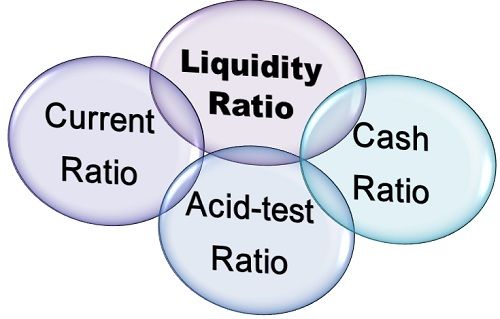Accounting ratios are important because they assist the management in their day to day financial decisions. They also help them evaluate the performance of the firm and make any changes that are deemed necessary. One aspect that the management has to focus on is to ensure that the firm maintains a certain level of liquidity. Liquidity ratios help them determine that. Let us study them.
Suggested Videos
Liquidity Ratios
A firm has assets and liabilities to its name. Some are fixed in nature and then there are current assets and current liabilities. These are short-term in nature and easily convertible into cash. The liquidity ratios deal with the relationship between such current assets and current liabilities.
Liquidity ratios evaluate the firm’s ability to pay its short-term liabilities, i.e. current liabilities. It shows the liquidity levels, i.e. how many of their assets can be quickly converted to cash to pay of their obligations when they become due.
It is not only a measure of how much cash there is but also how easily current assets can be converted to cash or marketable securities. Now let us look at some of the important liquidity ratios.

(Source: businessjargons)
Current Ratio
The current ratio is also known as the working capital ratio. It will measure the relationship between current assets and current liabilities. It measures the firm’s ability to pay for all its current liabilities, due within the next one year by selling off all their current assets. The formula for is as follows
Current Ratio = \(\frac{Current Assets}{Current Liabilities}\)
Browse more Topics under Accounting Ratios
- Meaning, Objectives, Advantages and Limitations of Ratio Analysis
- Types of Ratios
- Activity (or turnover) Ratios
- Solvency Ratios
- Profitability Ratios
Current Assets include,
- Stock
- Debtors
- Cash and Bank Balances
- Bills receivable
- Accruals
- Short term loans that are given
- Short term Securities
Current Liabilities include
- Creditors
- Outstanding Expenses
- Short Term Loans that are taken
- Bank Overdrafts
- Provision for taxation
- Proposed Dividend
The ideal current ratio, according to the industry standard is 2:1. That means that a firm should hold at least twice the amount of current assets than it has current liabilities. However, if the ratio is very high it may indicate that certain current assets are lying idle and not being utilized properly. So maintaining the correct balance between the two is crucial.
Quick Ratio
The other important one of the liquidity ratios is Quick Ratio, also known as a liquid ratio or acid test ratio. This ratio will measure a firm’s ability to pay off its current liabilities (minus a few) with only selling off their quick assets.
Now Quick assets are those which can be easily converted to cash with only 90 days notice. Not all current assets are quick assets. Quick assets generally include cash, cash equivalents, and marketable securities. The formula is
Quick Ratio = \(\frac{Quick Assets}{Current Liabilities/Quick Liabilities}\)
Quick Assets = All Current Assets – Stock – Prepaid Expenses
Quick Liabilities = All Current Liabilities – Bank Overdraft – Cash Credit
The ideal quick ratio is considered to be 1:1, so that the firm is able to pay off all quick assets with no liquidity problems, i.e. without selling fixed assets or investments. Since it does not take into consideration stock (which is one of the biggest current assets for most firms) it is a stringent test of liquidity. Many firms believe it is a better test of liquidity than the current ratio since it is more practical.
Absolute Cash Ratio
This is an even more rigorous liquidity ratio than quick ratio. Here we measure the availability of cash and cash equivalents to meet the short-term commitment of the firm. We do not consider all current assets, only cash. Let us see the formula,
Absolute Cash ratio = \(\frac{Cash + Bank Balance + Marketable Securities}{Current Liabilities}\)
As you can see, this ratio measures the cash availability of the firm to meet the current liabilities. There is no ideal ratio, it helps the management understand the level of cash availability of the firm and make any changes required.
However, if the ratio is greater than 1 it indicates poor resource management and very high liquidity. And high liquidity may mean low profitability.
Solved Examples for You
Q: Given Below is the Balance sheet of ABC Co. Analyze the Balance Sheet and Calculate the Current Ratio.
| Liabilities | Amount | Assets | Amount |
| Share Capital | 50,000 | Fixed Asset | 1,24,000 |
| Preference Share Capital | 30,000 | Short Term Capital | 10,000 |
| General Reserve | 40,000 | Debtors | 95,000 |
| Debentures | 60,000 | Stock | 50,000 |
| Trade Payable | 10,000 | Cash and Bank | 15,000 |
| Bank Overdraft | 20,000 | Discount on Share Issue | 6,000 |
| Provision for Tax | 40,000 | ||
| Provision for Depreciation | 20,000 | ||
| 3,00,000 | 3,00,000 |
Solution:
Current Ratio = \(\frac{Current Assets}{Current Liabilities}\)
Current Assets = Debtors + Stock + Cash + Short term Capital = 1,70,000
Current Assets = Trade Payables + Bank Overdraft + Provision for Taxes + Provision for Depreciation = 90,000
Current Ratio = \(\frac{170000}{90000}\) = 1.889 : 1
Q: Calculate Liquid Ratio from the given details.
| Current Liabilities | 65,000 |
| Current Assets | 85,000 |
| Stock | 20,000 |
| Advance Tax | 5,000 |
| Prepaid Expense | 10,000 |
Solution:
Quick Ratio = \(\frac{Quick Assets}{Current Liabilities/Quick Liabilities}\)
Quick Assets = All Current Assets – Stock – Prepaid Expenses = 85000 – (20000+5000+10000) = 50,000
Quick Liabilities = All Current Liabilities – Bank Overdraft – Cash Credit = 65,000
Quick Ratio = \(\frac{50000}{65000}\) = 0.77:1






Leave a Reply